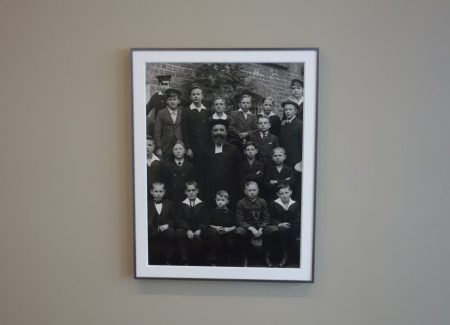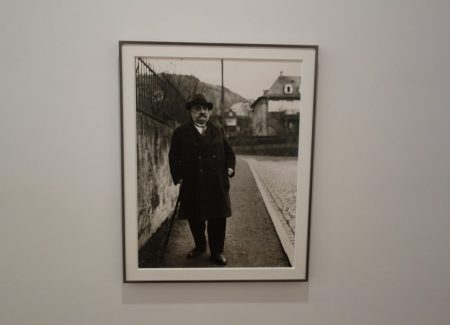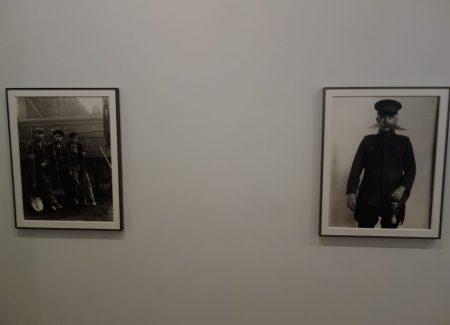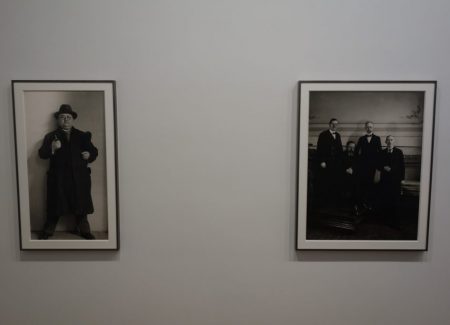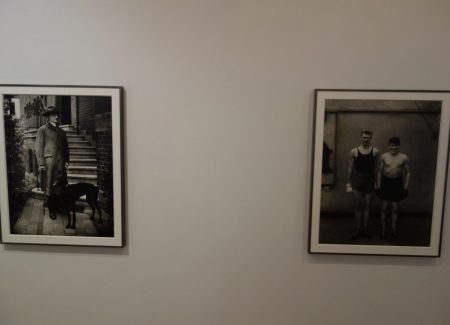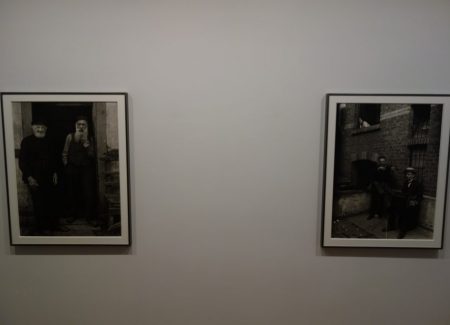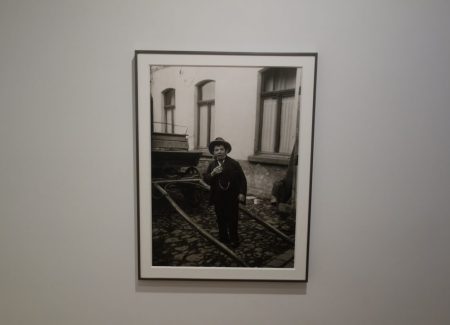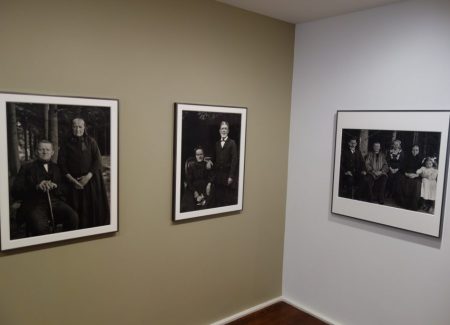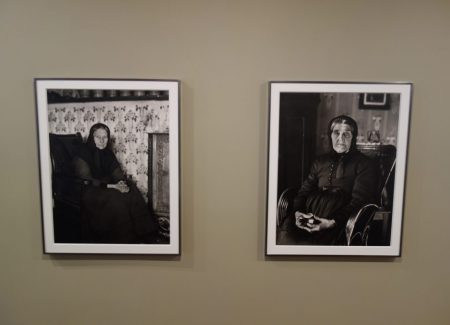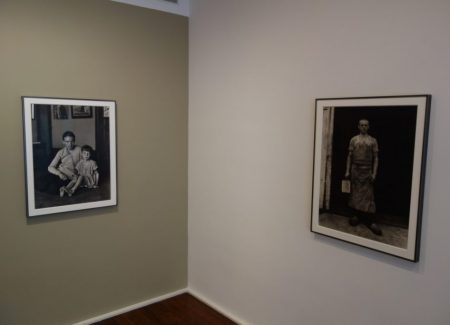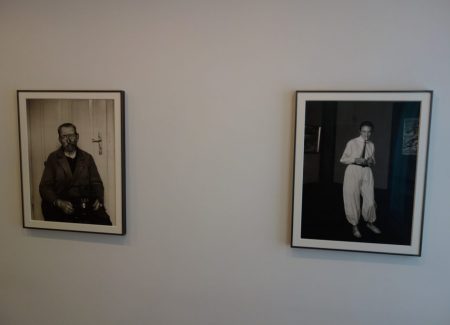JTF (just the facts): A total of 36 back and white photographs, framed in silver and thinly matted, and hung against white and almond colored walls in the galleries on the first and second floors. All of the works are oversized gelatin silver prints made in 1972 (posthumously) by Gunther Sander for inclusion in exhibition Men without Masks: Faces of Germany 1910 – 1938 at the Mannheimer Kunstverein. 12 of the works come from the Portfolio of Archetypes, the images taken between 1910 and 1925. The other 24 works on view were taken between 1913 and 1931. All of the prints are sized between roughly 31×19 and 32×24 and are unique in this size. (Installation shots below.)
Comments/Context: Earlier this year, Hauser & Wirth announced it was taking on the worldwide representation of the August Sander Family Collection. For many, this move wasn’t exactly obvious, as the well known, multi-location gallery currently has no vintage photographers in its stable and only a handful of contemporary artists that we might plausibly call intermittent photographers – Zoe Leonard is probably the most notable, with Roni Horn, Dan Graham, Mike Kelley, and Paul McCarthy also crossing over into the medium now and again.
Our first clue to the underlying logic behind the Sander tie up came with the recent Serialities group show, where Sander’s iconic portraits were the centerpiece of an expansive exhibit that drew connections between various contemporary artists working in series, categories, or typologies. And so we began to discern the hypothetical line of thinking – Hauser & Wirth wants to reposition Sander, subtly moving him away from the vintage photography world to potentially broaden the market for his work. The method being employed is to focus on Sander’s rigorous objectivity, a trait which is then extended to become a precursor to the wider themes and approaches of Conceptualism. In many ways, Sander’s importance then becomes an artistic story about repetitions of process and structure stripping out subjectivity, rather than one built on a decades-long sociological documentation and classification of German humanity and labor. And thus, Sander’s early projects, before the massive People of the Twentieth Century takes full shape, are recast as conceptual investigations of faces, “masks”, and an evolving process of standardizing the production of portraits so that the nuances of personality could come forth.
To lay out this logic more directly, this first solo show of Sander’s work put on by the gallery centers on some of the photographer’s earliest work, his Portfolio of Archetypes, largely made in the first half of the 1910s. These portraits capture generally older men and women in formal clothes (almost always black), mostly seen isolated or in pairs, and placed in seated three-quarter poses against dark backgrounds. These constraints lead to a group of images that reduce the portraits to facial studies, minimizing the other trappings of class or culture that might identify them. While “The Man of the Soil” leans on a cane and “The Philosopher” cradles his pipe, aside from a book or two (presumably the Bible), the photographs bring us into direct, unmediated interaction with age and experience. Craggy, wrinkled faces peer at us with sober confidence, each image the beginnings of an archetype.
In the successive decades, Sander’s ideas about the larger scope of types to be found in society led him to subjects that became much more varied. In particular, he began to take many more portraits in situ beyond the confines of the home or studio – on the streets, at places of labor, in gardens, and against handy blank walls. The rest of this show reprises many of his most notable images, from the severe painter Heinrich Hoerle and the boxers to the police officer with the handlebar mustache and the stylish painter’s wife Helene Abelen. As the years passed, Sander’s visual honesty never varied, his portraits of workers in the Ruhr, blacksmiths, and farmers from Leuscheid seen with the same openness as those of beggars, street musicians, and porters.
But when we consider Hauser & Wirth’s master repositioning plan, another problem presents itself – physical scale. Most of Sander’s original prints were roughly 11×9 or even smaller, requiring close up inspection and grids of many works to really get the flavor of Sander’s objective genius. So there had to be a plan for enlargement to better cater to the tastes of contemporary collectors and open up new avenues for sales beyond the dwindling stock of quality vintage material (just ask William Eggleston), hopefully without cranking out yet another set of posthumous prints. This show provides a surprising answer – an unearthed set of rare 1972 exhibition prints made by Sander’s son Gunther, each roughly 3X the normal print size. They’re the largest Sander prints I’ve ever seen and they open up some intriguing new avenues for inspecting Sander’s craft.
When seen at such massive scale, these exhibition prints make the dialogue between subject and viewer even more personal. And when Sander got the connection just right, the strength of the gaze in these pictures can be almost overpoweringly electric. Again and again, with a consistency that is wholly impressive, he waited for that exact moment when the eyes lock in and the sitter opens up to truly identify him or herself. It is that bond, across time, geography, and social class, that is so enduring. Of course, Sander’s meticulous attention to framing and composition helps make this happen. Aside from two images where a girl in a window and a dog force the photographer to unbalance the frame, every picture in this show is structured with evenly weighted precision, and the application of this repeated formal rigor also comes through more clearly when seen in these large prints.
While Sander may have been a master of the placement of his camera and the engagement with his sitters, these big prints prove that he was not a master of the technical details of focus. Roughly a quarter of these portraits inexplicably leave the face to fall into blur, a fact that may not have been as noticeable in his original prints. In these missteps, the focus often seems to perplexingly linger near the sitter’s midsection or lower – it falls on the aviator’s scarf, the blacksmiths’ anvil, the suitcoat of the high school student and the bailiff, and the body of the painter’s wife. The other technical detail to be uncovered in close inspection of these large prints is the amount of retouching that was necessary. A meaningful number of these negatives have multiple areas of tuning and clean up, which while likely not unusual for photographs from these years, wasn’t something I had actively observed or noticed before.
I have to admit there is something altogether thrilling about seeing Sander’s work printed so large, even when the images are familiar – it’s like we can finally really see and vicariously participate in these encounters, rather than having to look at them through a keyhole. Given that most major museum and private collections of photography already include examples from Sander’s People of the Twentieth Century, perhaps Hauser & Wirth’s active repositioning approach can open up some new collecting avenues with those who never saw the connection to or influence of Sander, or who don’t normally pay much attention to photography. For the rest of us who already have cemented Sander in the pantheon, the big prints on view here are undeniably worth a detour.
Collector’s POV: The prints in this show are priced at $195000 each, with the 12 print Portfolio of Archetypes available for $1200000. Back in 2015, we did a more systematic review of the secondary market for Sander’s work, detailing the various print types and editions sizes – this summary can be found here. The auction results for Sander’s prints since that time have not changed the overall conclusions outlined there.
